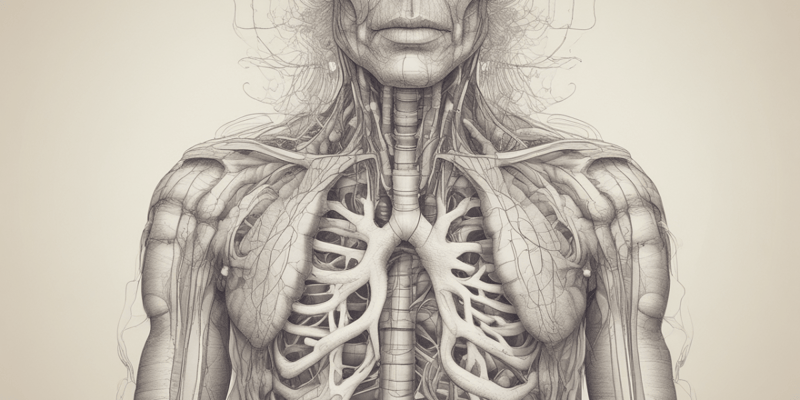Podcast
Questions and Answers
What is the primary function of the respiratory system?
What is the primary function of the respiratory system?
Which structure is responsible for sound production within the breathing system?
Which structure is responsible for sound production within the breathing system?
Where does gas exchange primarily occur in the respiratory system?
Where does gas exchange primarily occur in the respiratory system?
Which process is crucial for the diffusion of gases in the lungs?
Which process is crucial for the diffusion of gases in the lungs?
Signup and view all the answers
What happens to the thoracic cavity volume during inhalation?
What happens to the thoracic cavity volume during inhalation?
Signup and view all the answers
What does the diaphragm do during the process of exhalation?
What does the diaphragm do during the process of exhalation?
Signup and view all the answers
What role do pleurae serve in the respiratory system?
What role do pleurae serve in the respiratory system?
Signup and view all the answers
Which muscle group is primarily involved in increasing thoracic cavity volume during inhalation?
Which muscle group is primarily involved in increasing thoracic cavity volume during inhalation?
Signup and view all the answers
What feature of alveoli enhances their effectiveness in gas exchange?
What feature of alveoli enhances their effectiveness in gas exchange?
Signup and view all the answers
What is the effect of a higher partial pressure of oxygen in the alveoli?
What is the effect of a higher partial pressure of oxygen in the alveoli?
Signup and view all the answers
Study Notes
Anatomy of the Breathing System
- The respiratory system is responsible for gas exchange, bringing oxygen into the body and removing carbon dioxide.
- It consists of the nose, pharynx, larynx, trachea, bronchi, bronchioles, and lungs.
- The nose filters, warms, and humidifies inhaled air.
- The pharynx (throat) is a common passageway for air and food.
- The larynx (voice box) contains the vocal cords for sound production.
- The trachea (windpipe) is a rigid tube that carries air to the lungs.
- The trachea branches into two bronchi, which lead to the right and left lungs.
- The bronchi branch into smaller bronchioles, which terminate in tiny air sacs called alveoli.
- Alveoli are the primary sites of gas exchange in the lungs.
- The lungs are contained within the thoracic cavity, protected by the rib cage.
- Lungs are composed of elastic tissue and contain numerous alveoli arranged in clusters called acini.
- The diaphragm and intercostal muscles are involved in the mechanics of breathing.
- Pleurae are thin membranes that cover the lungs and line the thoracic cavity and allow smooth movement.
Diffusion of Gases
- Gas exchange occurs through diffusion, the movement of gases from an area of high concentration to an area of low concentration.
- In the lungs, oxygen from the inhaled air diffuses into the bloodstream, and carbon dioxide from the bloodstream diffuses into the alveoli to be exhaled.
- The alveoli have a large surface area and thin walls, promoting efficient gas exchange.
- Partial pressures of gases drive diffusion. Higher partial pressure of oxygen in the alveoli drives oxygen from the alveoli into the capillaries.
- The concentration gradient is important and the partial pressure difference is a critical factor for efficient diffusion.
- The blood in capillaries has a lower partial pressure of oxygen and a higher partial pressure of carbon dioxide than the air in the alveoli, resulting in the diffusion of gases.
Inhalation
- Inhalation (inspiration) is the process of bringing air into the lungs.
- The diaphragm contracts, and the intercostal muscles move the rib cage up and out, expanding the thoracic cavity.
- The increase in thoracic cavity volume decreases the pressure inside the lungs, creating a pressure gradient that pulls air into the lungs.
- This expansion creates negative pressure inside the lungs, drawing air in.
Exhalation
- Exhalation (expiration) is the process of expelling air from the lungs.
- The diaphragm relaxes and the intercostal muscles recoil, causing the thoracic cavity to decrease in volume.
- The decrease in thoracic cavity volume increases the pressure inside the lungs, creating a pressure gradient that forces air out of the lungs.
- This is a passive process, with the lungs and chest wall recoiling to their initial positions.
Studying That Suits You
Use AI to generate personalized quizzes and flashcards to suit your learning preferences.
Description
Explore the intricate structure of the respiratory system, a vital component for gas exchange. Learn about the various parts including the nose, pharynx, larynx, trachea, bronchi, and lungs, and their specific roles in breathing and sound production.




